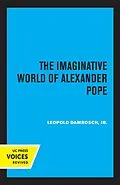The Imaginative World of Alexander Pope examines the complex and multilayered world created by one of the most significant poets of the 18th century. The book focuses on how Alexander Pope, while rooted in the ideals of the Augustan age, bridges the transition to modern poetic sensibilities. Central to this exploration is Pope's effort to reconcile the traditional symbolic orders of the Renaissance with the emerging uncertainties of modernity. By "stooping to truth," as Pope himself phrased it, he sought to reflect the external world with a sharp moral lens while grappling with the limitations of subjective perception and societal fragmentation. His works, including Essay on Man and the biting satires of his later career, reveal his struggle to balance the idealized order he aspired to uphold with the chaotic and evolving realities of his time.
This thematic study presents Pope as both an inheritor of classical traditions and an innovator navigating the birth of the modern age. Drawing extensively from Pope's contemporaries, letters, and cultural context, the book highlights the poet's nuanced position as both a critic and participant in the socio-political currents of 18th-century England. It also challenges traditional and reductive interpretations of his work, proposing that Pope's fragmented sense of order and his deeply personal connections to his era provide the foundation for his enduring relevance. In doing so, it offers a fresh perspective on Pope as a pivotal figure whose imaginative world continues to resonate, embodying the tensions and contradictions of his age with remarkable vitality.
This title is part of UC Press's Voices Revived program, which commemorates University of California Press's mission to seek out and cultivate the brightest minds and give them voice, reach, and impact. Drawing on a backlist dating to 1893, Voices Revived makes high-quality, peer-reviewed scholarship accessible once again using print-on-demand technology. This title was originally published in 1987.
Autorentext
Enter the Author Bio(s) here.
